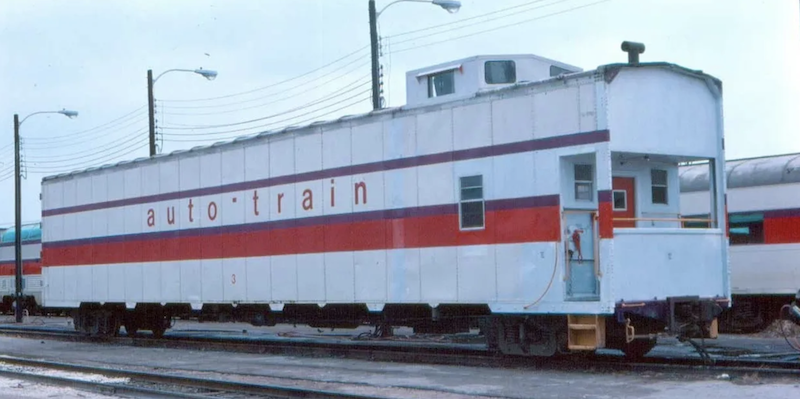By Eric Berger
An effort is underway to save one of the most unusual remnants of the original Auto-Train operation of the 1970s, a combination car carrier and caboose that was rostered as AT 3. Funds are being raised by Florida Adventures in Railroading to cover the estimated $30,000 of acquiring, preparing and moving the car from an at-risk location in California to a new home in its native Florida
In 1971, privately-owned Auto-Train began hauling passengers and their cars behind a colorful fleet of new General Electric U36B locomotives between Lorton, Va., and Sanford, Fla., over the rails of Seaboard Coast Line and Richmond, Fredericksburg & Potomac. Passengers rode in dome cars, coaches and diners acquired mostly from Western railroads that no longer needed them after turning over responsibility for long-distance passenger trains to Amtrak earlier in the year. Automobiles rode in double-deck auto-rack boxcars built in 1966 for Canadian National. The 75-foot cars held eight automobiles each. The service was a hit and validated the vision of Auto-Train founder Eugene K. Garfield.
Following success on the original route, service between Sanford and Louisville, Ky., was added in May 1974. The company converted former FEC boxcars into cabooses to trail the original trainsets, but for the Louisville service, a crew cabin and a cupola were added at the tail end the former CN 730027 and two others. It would spend just three years in its role as AT 3, and would trail the final run to Louisville in September 1977. The failure of the Louisville service, increasing costs and both bad publicity and liability issues arising from accidents contributed to the company’s demise in 1981. The service was revived by Amtrak two years later.
The caboose was sold at auction and became part of the rolling stock at Fillmore & Western, which became known as “Home of the Movie Trains” during its 30 years of operation on former Southern Pacific tracks owned by Ventura County. It is the only surviving Auto-Train caboose. The oddly outsized caboose has appeared in the background of various movies and commercials, making a cameo appearance in the 1993 video for the Aerosmith song “Cryin’.”
The F&W era came to an end last year after Sierra Railroad won the latest lease on the tracks and AT 3 was not among the equipment Sierra chose to keep. It was by chance that a group of former Auto-Train employees learned that it was in danger of being scrapped when they gathered for a reunion in Lorton in 2021. That led to the involvement of Florida Adventures In Railroading, a not-for-profit preservation organization that is working to bring the car to Orange Park, Fla., for restoration.
For more information visit flair.org.



